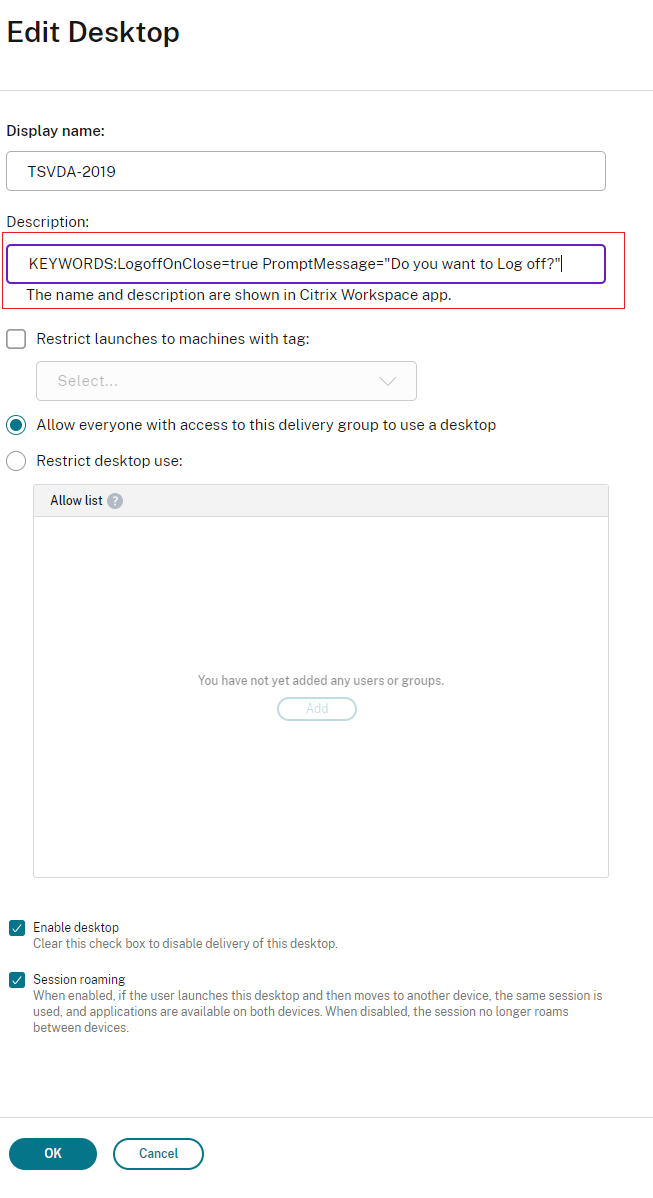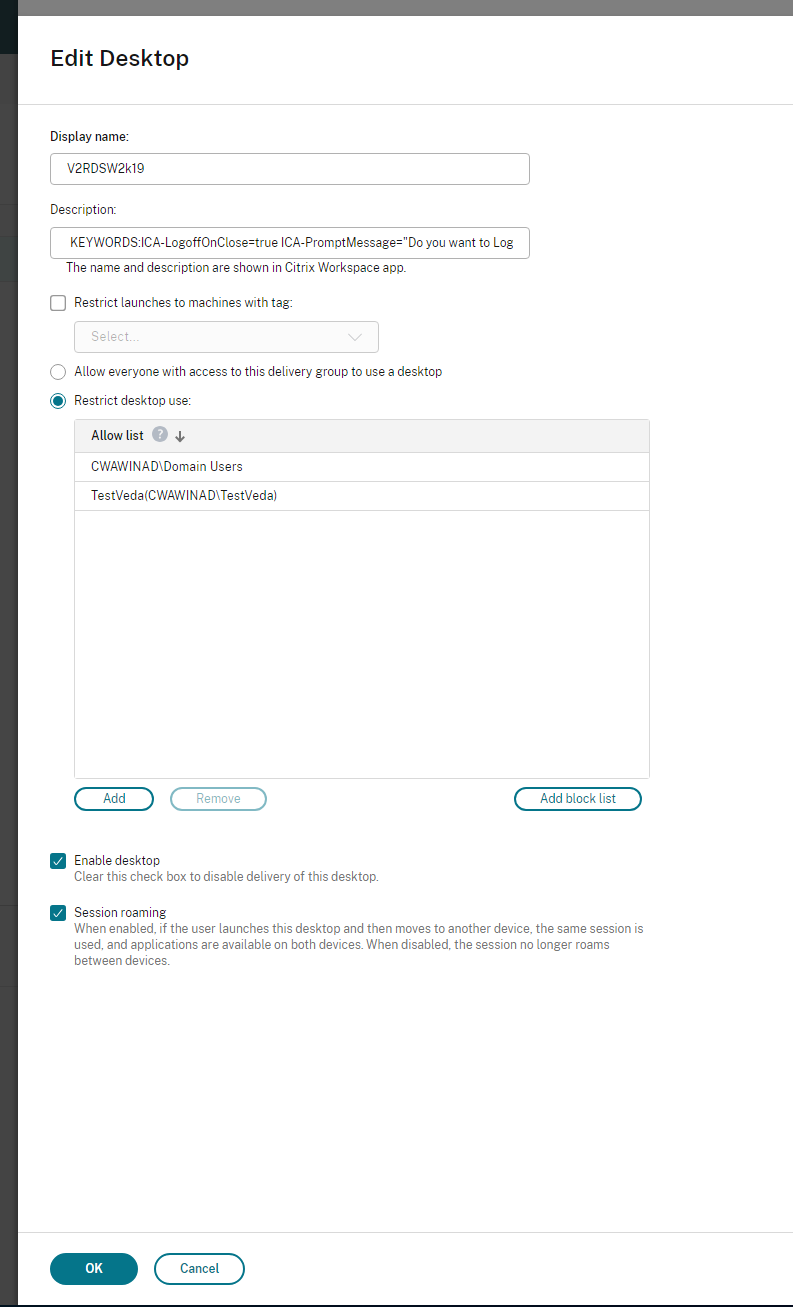Session experience
Application launch time
Use the session prelaunch feature to reduce application launch time during normal or high traffic periods, thus providing users with a better experience. The prelaunch feature allows to create a prelaunch session. Prelaunch session is created when a user logs on to Citrix Workspace app, or at a scheduled time if the user has signed in.
The prelaunch session reduces the launch time of the first application. When a user adds new account connection to Citrix Workspace app for Windows, session prelaunch doesn’t take effect until the next session. The default application ctxprelaunch.exe is running in the session, but it is not visible to you.
For more information, see session prelaunch and session linger guidance in the Citrix Virtual Apps and Desktops article titled Manage delivery groups.
Session prelaunch is disabled by default. To enable session prelaunch, specify the ENABLEPRELAUNCH=true parameter on the Workspace command line or set the EnablePreLaunch registry key to true. The default setting, null, means that prelaunch is disabled.
Note:
If the client machine has been configured to support Domain Passthrough (SSON) authentication, prelaunch is automatically enabled. If you want to use Domain Pass-through (SSON) without prelaunch, set the EnablePreLaunch registry key value to false.
The registry locations are:
-
HKEY_LOCAL_MACHINE\Software\[Wow6432Node\]Citrix\\Dazzle -
HKEY_CURRENT_USER\Software\Citrix\Dazzle
There are two types of prelaunch:
- Just-in-time prelaunch- prelaunch starts immediately after the user’s credentials are authenticated whether it is a high-traffic period. Typically used for normal traffic periods. A user can trigger just-in-time prelaunch by restarting the Citrix Workspace app.
- Scheduled prelaunch- prelaunch starts at a scheduled time. Scheduled prelaunch starts only when the user device is already running and authenticated. If those two conditions are not met when the scheduled prelaunch time arrives, a session does not launch. To share network and server load, the session launches within a window when it is scheduled. For example, if the scheduled prelaunch is scheduled for 13:45, the session actually launches between 13:15 and 13:45. Typically used for high-traffic periods.
Configuring prelaunch on a Citrix Virtual Apps server consists of:
- creating, modifying, or deleting prelaunch applications, and
- updating user policy settings that control the prelaunch application.
You cannot customize the prelaunch feature using the receiver.admx file. However, you can change the prelaunch configuration by modifying registry values. Registry values can be modified during or after Citrix Workspace app for Windows installation.
- The HKEY_LOCAL_MACHINE values are written during client installation.
- The HKEY_CURRENT_USER values enable you to provide different users on the same machine with different settings. Users can change the HKEY_CURRENT_USER values without administrative permission. You can provide your users with scripts to change the values.
HKEY_LOCAL_MACHINE registry values:
For 64-bit Windows operating systems: HKEY_LOCAL_MACHINE\SOFTWARE\Wow6432Node\Citrix\ICA Client\Prelaunch
For 32-bit Windows operating systems: HKEY_LOCAL_MACHINE\SOFTWARE\Citrix\ICA Client\Prelaunch
Name: UserOverride Type: REG_DWORD
Values:
0 - Use the HKEY_LOCAL_MACHINE values even if HKEY_CURRENT_USER values are also present.
1 - Use the HKEY_CURRENT_USER values if they exist; otherwise, use the HKEY_LOCAL_MACHINE values.
Name: State Type: REG_DWORD
Values:
0 - Disable prelaunch.
1 - Enable just-in-time prelaunch. (prelaunch starts after the user’s credentials are authenticated.)
2 - Enable scheduled prelaunch. (prelaunch starts at the time configured for Schedule.)
Name: Schedule Type: REG_DWORD
Value:
The time (24-hour format) and days of a week for the scheduled prelaunch entered in the following format:
| HH:MM | M:T:W:TH:F:S:SU where HH and MM are hours and minutes. M:T:W:TH:F:S:SU is the days of the week. For example, to enable scheduled prelaunch on Monday, Wednesday, and Friday at 13:45, set Schedule as Schedule=13:45 | 1:0:1:0:1:0:0. The session actually launches between 13:15 and 13:45. |
HKEY_CURRENT_USER registry values:
HKEY_CURRENT_USER\SOFTWARE\Citrix\ICA Client\Prelaunch
The State and Schedule keys have the same values as for HKEY_LOCAL_MACHINE.
Desktop Viewer
Different enterprises might have different corporate needs. Your requirements for the way users access virtual desktops might vary from user to user and as your corporate needs evolve. The user experience of connecting to virtual desktops and the extent at which the user can configure the connections depend Citrix Workspace app for Windows setup.
Use the desktop viewer when users need to interact with their virtual desktop. The user’s virtual desktop can be a published virtual desktop, or a shared or dedicated desktop. In this access scenario, the Desktop Viewer toolbar functionality allows the user to open a virtual desktop in a window and pan and scale that desktop inside their local desktop. Users can set preferences and work on more than one desktop using multiple Citrix Virtual Apps and Desktops and Citrix DaaS connections on the same user device.
Note:
Use Citrix Workspace app to change the screen resolution on their virtual desktops. You can’t change Screen Resolution using the Windows Control Panel.
Keyboard input in Desktop Viewer
In Desktop Viewer sessions, the Windows logo key+L is directed to the local computer.
Ctrl+Alt+Delete is directed to the local computer.
Key presses that activate certain Microsoft accessibility features, for example, Sticky Keys, Filter Keys, and Toggle Keys are normally directed to the local computer.
As an accessibility feature of the Desktop Viewer, pressing Ctrl+Alt+Break displays the Desktop Viewer toolbar buttons in a pop-up window.
Ctrl+Esc is sent to the remote, virtual desktop.
Note:
By default, if the Desktop Viewer is maximized, Alt+Tab switches focus between windows inside the session. If the Desktop Viewer is displayed in a window, Alt+Tab switches focus between windows outside the session.
Hotkey sequences are key combinations designed by Citrix. Hotkey sequences are, for example, the Ctrl+F1 sequence reproduces Ctrl+Alt+Delete, and Shift+F2 switches applications between full-screen and windowed mode.
Note:
You can’t use hotkey sequences with virtual desktops displayed in the Desktop Viewer, that is, with virtual apps and desktops sessions. However, you can use them with published applications, that is, with virtual apps sessions.
Status indicator time-out
You can change the amount of time the status indicator displays when a user is launching a session.
To alter the time-out period, do the following steps:
- Launch the Registry Editor.
- Navigate to the following path:
- On a 64-bit:
HKEY_LOCAL_MACHINE\SOFTWARE\Wow6432Node\Citrix\ICA CLIENT\Engine - On a 32-bit:
HKEY_LOCAL_MACHINE\SOFTWARE\Citrix\ICA CLIENT\Engine\
- On a 64-bit:
- Create a registry key as follows:
- Type: REG_DWORD
- Name:
SI INACTIVE MS - Value: 4, if you want the status indicator to disappear sooner.
When you configure this key, the status indicator might appear and disappear frequently. This behavior is as designed. To suppress the status indicator, do the following:
- Launch the Registry Editor.
- Navigate to the following path:
- On a 64-bit:
HKEY_LOCAL_MACHINE\SOFTWARE\Wow6432Node\Citrix\ICA CLIENT\ - On a 32-bit:
HKEY_LOCAL_MACHINE\SOFTWARE\Citrix\ICA CLIENT\
- On a 64-bit:
-
Create a registry key as follows:
- Type: REG_DWORD
- Name:
NotificationDelay - Value: Any value in millisecond (for example, 120000)
Improved virtual apps and desktops reconnection experience
Citrix Workspace 2302 release provides an enhanced user experience while reconnecting to virtual apps and desktops from which you got disconnected.
When Citrix Workspace app attempts to refresh the disconnected Citrix Workspace app or start new virtual apps or desktops as a part of the Workspace Control feature, the following prompt appears:

This prompt appears only when the show reconnection prompt to reconnect sessions is set to true in the Global App Configuration service.
Click Restore to reconnect to open new and disconnected virtual apps and desktops. If you want to start only newly selected apps and desktops, click Cancel.
You can also select Remember my preference to apply the selected preference for the next login.
The preceding new Restore session? prompt appears only if:
- the user tries to start an app belonging to a workspace store,
- admin policies or app config settings are not configured for the Workspace Control feature,
- Workspace Control Reconnect options are set to default on the client.
Note:
Reconnect settings in the Reconnect Options takes precedence over the preferences set in the dialog box. For more information, see Configure reconnect options using Advanced Preferences dialog.
Sustainability initiative from Citrix Workspace app
For native launch
From Citrix Workspace app 2309 version onwards, when this feature is enabled, a prompt is displayed to sign out from the desktop session when a user closes a virtual desktop. This feature might help conserve energy if there are Windows OS policies that are used to shutdown VMs when no users are logged in.
To enable this feature, do the following:
- Navigate to Citrix Studio.
- Click Delivery Groups from the left navigation pane.
- Select the required VDA from the Delivery Group section.
- Click the Edit icon. The Edit Delivery Group page appears.
- Click Desktops from the left navigation pane.
- Select the required VDA where you must add the keywords.
- Click Edit. The Edit Desktop page appears.
- Set the
LogoffOnClosekeyword to true in the Description field. -
Click OK. The following dialog box appears when you close the virtual desktop:

Customizing the text in the Save energy screen
You can also customize the text in the Save energy screen.
- Follow steps 1–8 in the preceding section.
-
Set the
PromptMessagekeyword to the required text in the Description field.Example:
KEYWORDS:LogoffOnClose=true PromptMessage="Do you want to Log off?" <!--NeedCopy-->
The keywords are assigned by default for new desktop machines assigned to the group. For existing desktop machines, you must run the following powershell commands for changes to apply:
$dg = Get-BrokerDesktopGroup -Name '<group name>' -Property 'Name','Uid' $apr = @( Get-BrokerAssignmentPolicyRule -DesktopGroupUid $dg.Uid -Property 'Description' ) Get-BrokerMachine -DesktopGroupUid $dg.Uid -IsAssigned $true | Set-BrokerMachine -Description $apr[0].Description <!--NeedCopy-->With this PowerShell script, it is possible to have multiple assignment policy rules for a single Delivery Group. Using Citrix Studio also, you can configure multiple Assignment policy rules, each with unique description value and possible set of different keywords.
-
Click OK. The following dialog box appears when you close the virtual desktop.

For hybrid cloud launch
To enable this feature, do the following:
- Navigate to Citrix Studio.
- Click Delivery Groups from the left navigation pane.
- Select the required VDA from the Delivery Group section.
- Click the Edit icon. The Edit Delivery Group page appears.
- Click Desktops from the left navigation pane.
- Select the required VDA where you must add the keywords.
- Click Edit. The Edit Desktop page appears.
- Set the
ICA-LogOffOnClosekeyword to true in the Description field. -
Click OK. The following dialog box appears when you close the virtual desktop:

Customize the text on the Save energy screen
You can also customize the text that appears on the Save energy screen.
- Follow steps 1–8 in the preceding section.
-
Set the
ICA-PromptMessagekeyword to the required text in the Description field.Note:
The maximum number of characters allowed in the Description field is 200.
Example:
KEYWORDS:ICA-LogOffOnClose=true ICA-PromptMessage="Do you want to Log off?" <!--NeedCopy-->
The keywords are assigned by default for new desktop machines assigned to the group. For existing desktop machines, you must run the following PowerShell commands for changes to apply:
$dg = Get-BrokerDesktopGroup -Name '<group name>' -Property 'Name','Uid' $apr = @( Get-BrokerAssignmentPolicyRule -DesktopGroupUid $dg.Uid -Property 'Description' ) Get-BrokerMachine -DesktopGroupUid $dg.Uid -IsAssigned $true | Set-BrokerMachine -Description $apr[0].Description <!--NeedCopy-->With this PowerShell script, it’s possible to have multiple assignment policy rules for a single Delivery Group. Using Citrix Studio also, you can configure multiple Assignment policy rules, each with a unique description value, and a possible set of different keywords.
-
Click OK. The following dialog box appears when you close the virtual desktop.
